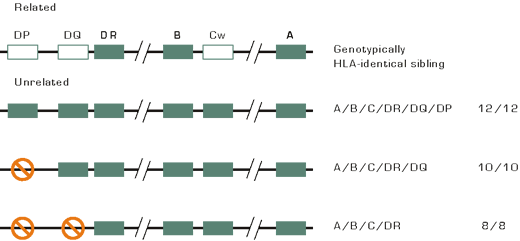In the last issue of Blood in 2007, two articles reported results of transplants from unrelated donors using HLA matching. The journal article by Stephanie Lee and coworkers addresses the relative importance of various HLA loci and the resolution level at which they are matched for unrelated donor transplantation. To address this question, National Marrow Donor Program data from 3,857 U.S. transplantations performed from 1988 to 2003 were analyzed. Patient-donor pairs were fully typed for HLA-A, B, C, DRB1, DQB1, DQA1, DPB1, and DPA1 alleles (see Figure). High-resolution DNA matching for HLA-A, B, C, and DRB1 (8/8 match) was the minimum level of matching associated with the highest survival. A single mismatch detected by low- or high-resolution DNA testing at HLA-A, B, C, or DRB1 (7/8 match) was associated with higher mortality (relative risk 1.25, p<0.0001) and one-year survival of 43 percent compared to 52 percent for 8/8 matched pairs. Single mismatches at HLA-B or HLAC appear better tolerated than mismatches at HLA-A or HLA-DRB1. Mismatching at two or more loci compounded the risk. Mismatching at HLA-DP or DQ loci and donor factors other than HLA type were not associated with survival.
In the second paper, Brownen Shaw, et al. examined the extent to which transplant outcome may be improved with donor matching for HLA-DP. The risks of acute GVHD, relapse, and mortality associated with HLA-DPB1 allele mismatching were determined in 5,929 patients who received a myeloablative HCT from an HLA-A, B, C, DRB1, DQB1 matched or mismatched donor. There was a statistically significantly higher risk of both grade II-IV aGVHD (OR=1.33, p<0.0001) and grade III-IV aGVHD (OR=1.26, p=0.0007) after HCT from an HLA-DPB1 mismatched donor compared to a matched donor. The increased risk of acute GVHD was accompanied by a statistically significant decrease in disease relapse (HR=0.82, p=0.01).
Historically, the selection of potential donors for hematopoietic cell transplantation (HCT) relied on serological tests for donor-recipient identity for classical HLA-A, B, and DR antigens. Later, as molecular methods for typing HLA genes became available, the degree of diversity of this region became apparent. When such typing methods were applied to the analysis of HCT recipients and donors, many serologically identical, unrelated donor recipients were found to harbor mismatches between two unique alleles of the same antigen. Clinical studies have demonstrated that such allelic differences are clinically relevant, increasing the risks of graft failure, acute GVHD, and mortality.
In Brief
The first study by Lee and coworkers clearly highlights the fact that there is a 10 percent loss of survival with any mismatch (although, of marginal significance for HLA-DQ), but also that classical risk factors including patient age, race, disease stage, and CMV status were as predictive of survival as donor HLA matching. The second study by Shaw and coworkers confirms in a large number of patients that DPB1 functions as a classical transplantation antigen. The increased risk of GVHD associated with HLA-DPB1 mismatching is accompanied by a lower risk of relapse.
Numerous studies have looked at the impact of HLA matching and transplant outcomes. However, some older data did not include molecular typing for all HLA alleles, thus bringing into question some of the reported results. The data reviewed here (and reported in a few other articles) have led to the current gold standard of a fully matched "10/10" unrelated donor being one who is allele matched for HLA-A, B, C, DRB1, and DQB1. Few patients have a 12/12 donor (also matched for HLA-DPB1), which means they may have less of a risk of GVHD, but more of a risk of relapse. We already know that even a 10/10 molecularly matched donor/recipient pair have three out of four chances to be haplotype-mismatched1 and of greater disparities if typed for other non-HLA gene polymorphism or for KIR… Thus, in 2008, it’s probably time to stop using the term matched for an unrelated donor (unless specified by the number of molecularly tested loci). However, compelling evidence coming from large series strongly suggests that transplant from 10/10 molecularly matched donors led to results (survival) similar to those obtained with HLA-identical sibling donors — a finding that, in the end, constitutes the only relevant criterion for physicians.
References
Competing Interests
Dr. Socié indicated no relevant conflicts of interest.

